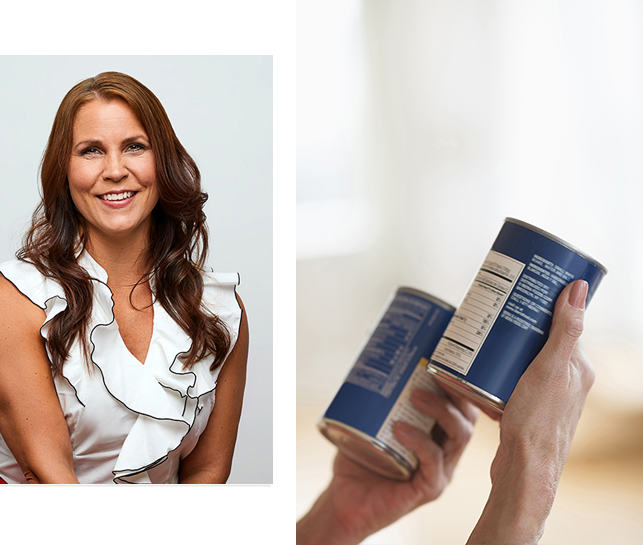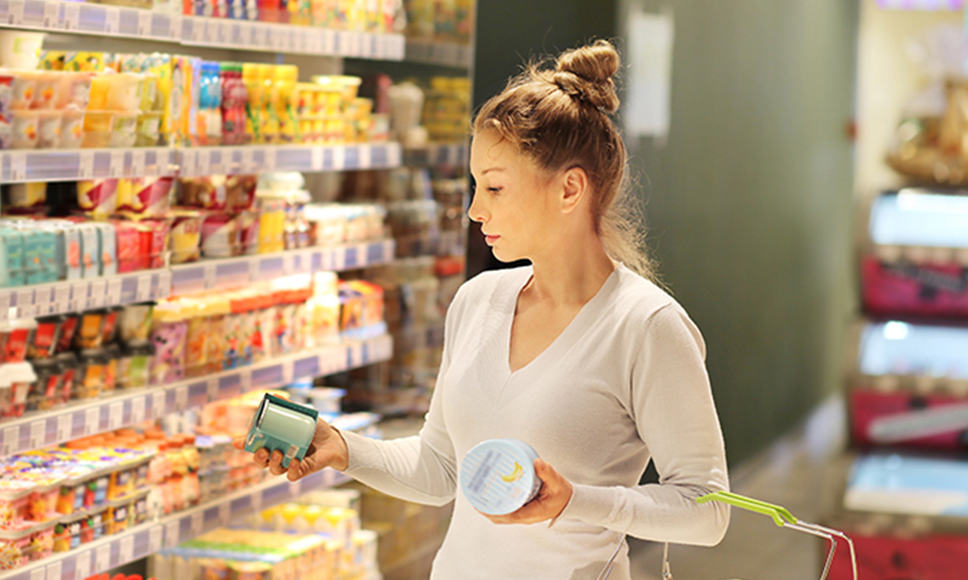Do you really know what to look for on food packaging when you’re grocery shopping? Most of us think we know, but research suggests that we actually don’t! And no wonder – it’s complicated. Oriflame’s dietitian Marlene Nordlander agrees: ‘Food packaging can be a bit of a minefield for us all – it can take some know-how to analyse and interpret the ingredients and nutrition information in a meaningful way.’ I asked Marlene if she had any little tricks to help us choose healthier, faster.
1. Front of pack claims can sometimes be misleading
Julie: Let’s talk about food packaging on the shelf in the supermarket. What you see on the front is designed to be attractive and appealing – to make us want to buy it basically.
Marlene: That’s right. And while all food claims are strictly regulated in most countries, they can still sometimes make a product seem healthier than it maybe is – low fat, low sugar, high protein and so on.
J: So what you’re saying is that we shouldn’t take these claims at face value?
M: Right! There’s nothing wrong with these claims but they don’t necessarily tell the whole story, so it’s always a good idea to turn the pack over and check the ingredients list and nutritional information for a fully informed choice.
2. How many calories?
J: Is it true that we should never look at just one product?
M: Absolutely. You’ll get a better overview if you compare at least two similar products as they can have quite different nutritional profiles. Even different flavours of products can have different ingredients, different nutritional profiles!
J: So, where do you start? Do you look at calories first?
M: Yes. Most of us consume too many calories per day so calories are important to look at, regardless of product category. Look for the calories per 100g first (kcal in the nutritional information). This measurement is there to help you compare products and make an informed choice. From there you can check the calories per serving – but you should be aware that serving sizes are determined by the manufacturer, so they can vary from one product to the next and may not match your idea of a satisfactory portion.
3. Compare nutrition information and ingredients on food labels
J: What else is important when comparing similar products?
M: It’s important to know that product ingredients are listed in the order from the highest to lowest content by weight. A good rule of thumb is to pay particular attention to the first three ingredients as these are often the bulk of what you will be eating.

4. Grocery shopping tips
J: So is there anything special we should look out for with different products?
M: Well if you’re looking for a carbohydrate-based food like bread or breakfast cereal, you really want to see a high percentage of whole grains, high fibre and low added sugar. With protein snack shakes, like our Natural Balance Shake, you should look for high protein, but they can be sweetened so check there’s no added sugar. Ready meals can be healthy but some tend to be quite high in fat so I would try and go for those “lighter” options or check the fat sources for unsaturated rather than saturated fat.
5. Be mindful of highly processed foods
J: Should we even eat processed foods? I thought it was better to make everything myself.
M: Well of course fresh, home-prepared food is often better but we all need processed foods in our busy lives – it’s a fact. What’s important is choosing the right processed foods – with high protein and dietary fibre – rather than the ultra-processed, hyperpalatable foods.
J: Can you give me an example?
M: These are the foods that make your mouth water just thinking of them – things like burgers and fries, potato chips, cookies and cake! Delicious? Absolutely! But check out the back of the pack – they’re generally high in calories, low in nutrients and tend to be high in sugar, salt and fat. You don’t need to avoid these foods completely but do try to eat them in moderation so they don’t compete with more nutritious foods in your diet.
Help telling the good from the bad on food labels
J: Are there any other ways to identify healthy products?
M: Yes! I know I said don’t just look at the front of the pack, but sometimes you can find a helping hand there too! In some countries there is a logo, which shows that a product has been rated as a healthier choice by the government food agency, based on things like lower added sugar and salt content, higher fibre and healthier fats. In Sweden it’s a green keyhole logo. Look out for an equivalent in your part of the world!
J: A quick recap on the main points – always compare products; look at the ingredients and nutrition information on the back of the pack; start with calories per 100g; avoid super-processed foods with added sugars, salt and saturated fats, and look out for your country’s healthy food logo. Thanks Marlene – great tips for faster shopping and healthier eating.



